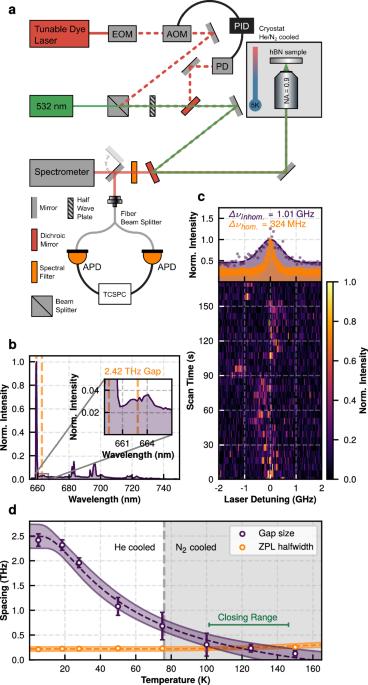探测六方氮化硼中机械解耦缺陷中心的相干光控制极限
IF 9.6
Q1 MATERIALS SCIENCE, MULTIDISCIPLINARY
引用次数: 0
摘要
两级系统的相干控制是现代量子光学最基本的挑战之一。了解其基本局限性对于实现下一代量子设备也至关重要。两级系统的量子相干性非常脆弱,尤其是当两级系统通过光学转换连接在一起时。当这种量子发射器位于固体中时,其相干性会受到光学转变与固态环境相互作用的影响,这就要求将样品冷却到几开尔文或更低的温度。在这里,我们利用六方氮化硼中机械隔离的量子发射器来探索在共振驱动下影响光学转变相干性的各种机制。我们在机械隔离崩溃的阈值下运行该系统,以研究去相干的开始和温度依赖性,并独立于光谱扩散。对基本物理退相干机制的深入研究揭示了一个温度极限,在此温度极限之前,系统的相干驱动是可能的。这项研究有助于提高基于 hBN 的量子器件的工作温度,从而减少对低温冷却的需求。两级系统的相干控制是量子器件的核心,了解退相干机制对于提高其工作温度至关重要。在此,我们利用六方氮化硼中机械隔离的量子发射器来探索在共振驱动下影响光学转变相干性的各种机制。本文章由计算机程序翻译,如有差异,请以英文原文为准。

Probing the limits for coherent optical control of a mechanically decoupled defect center in hexagonal boron nitride
The coherent control of a two-level system is among the most essential challenges in modern quantum optics. Understanding its fundamental limitations is crucial, also for the realization of next generation quantum devices. The quantum coherence of a two-level system is fragile in particular, when the two levels are connected via an optical transition, which, at the same time, enables the manipulation of the system. When such quantum emitters are located in solids the coherence suffers from the interaction of the optical transition with the solid state environment, which requires the sample to be cooled to temperatures of a few Kelvin or below. Here, we use a mechanically isolated quantum emitter in hexagonal boron nitride to explore the individual mechanisms which affect the coherence of an optical transition under resonant drive. We operate the system at the threshold where the mechanical isolation collapses in order to study the onset and temperature-dependence of dephasing and independently of spectral diffusion. The insights on the underlying physical decoherence mechanisms reveal a limit in temperature until which coherent driving of the system is possible. This study enables to increase the operation temperature of hBN-based quantum devices, therefore reducing the need for cryogenic cooling. The coherent control of a two-level system is at the core of quantum devices and understanding decoherence mechanisms is crucial for increasing their operating temperatures. Here, a mechanically isolated quantum emitter in hexagonal boron nitride is used to explore the individual mechanisms affecting the coherence of an optical transition under resonant drive.
求助全文
通过发布文献求助,成功后即可免费获取论文全文。
去求助
来源期刊

Communications Materials
MATERIALS SCIENCE, MULTIDISCIPLINARY-
CiteScore
12.10
自引率
1.30%
发文量
85
审稿时长
17 weeks
期刊介绍:
Communications Materials, a selective open access journal within Nature Portfolio, is dedicated to publishing top-tier research, reviews, and commentary across all facets of materials science. The journal showcases significant advancements in specialized research areas, encompassing both fundamental and applied studies. Serving as an open access option for materials sciences, Communications Materials applies less stringent criteria for impact and significance compared to Nature-branded journals, including Nature Communications.
 求助内容:
求助内容: 应助结果提醒方式:
应助结果提醒方式:


